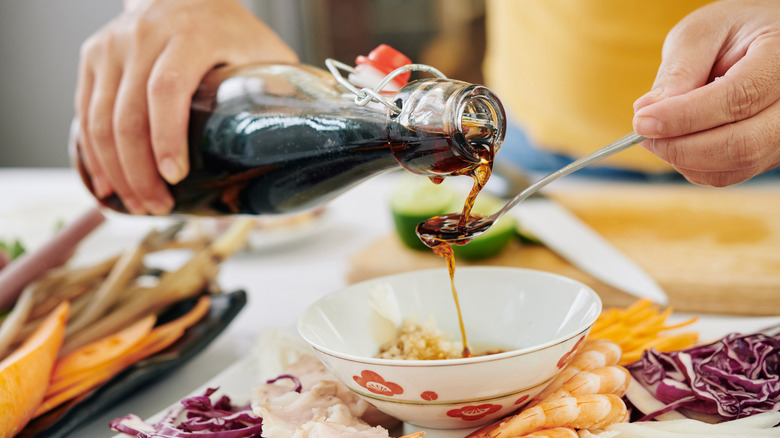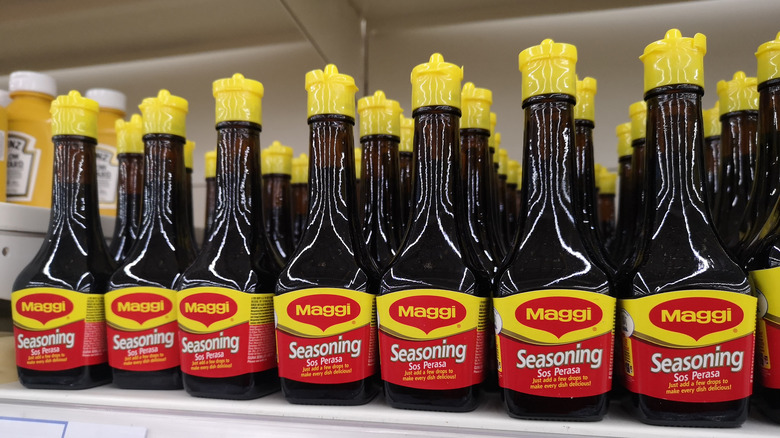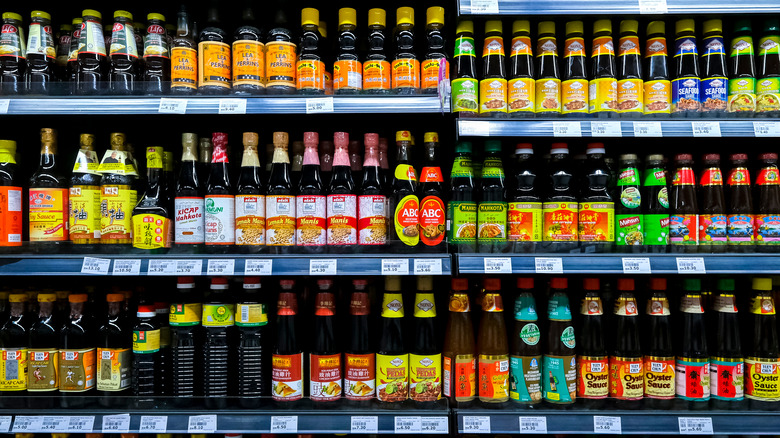The Difference Between Maggi Seasoning And Soy Sauce
Soy sauce is a popular addition to a variety of savory dishes around the world from smoked meats to chicken stir fry to tangy salads, per Kikkoman. It's one of the oldest and most versatile condiments in the book according to China Live, hailing from China in around 500 B.C. (Although its exact origins are still debated, per Saveur). Still, it's not the only flavor-enhancing condiment of its kind. While you probably know soy sauce by now, you might not be as familiar with its close cousin, the Maggi seasoning.
With roots in the late 1800s in Switzerland, per Nestlé, Maggi is best used in dishes like hearty soups, flavorful sauces, pasta, and even in your Bloody Mary. Both soy sauce and Maggi share many similarities, like a rich umami flavor, but they differ in other ways too. They're some of the most versatile additions you can add to a pan, so they're always good to have on hand or keep in the pantry. So where do the two diverge?
All about two of the world's most savory sauces
While it may not be as well known in the U.S., people use Maggi all around the world in places like Mexico and Japan, according to the Chicago Tribune. The savory sauce is popular because it brings a kick of smoky, tangy umami to anything it touches. Per Nestlé, Maggi's origins stem from the late 1800s when Julius Maggi looked to create better food options for the working class. He later ended up selling the seasonings he used inside his soups and called it Maggi. It became an inexpensive substitute for broth and has many different uses today.
Soy sauce was initially invented as a way to help preserve meats using salt and soybeans, per China Live. While the taste has evolved since its founding in around 500 B.C., modern soy sauce has a combination of umami, salty, and bitter notes. The flavors stem from soy sauce's basic makeup of fermented soybeans. (But most sauces also contain wheat flour.) According to Saveur, soy sauce is a cooking essential today in cuisine from China, Japan, Southeast Asia, and Korea.
How Maggi and soy sauce differ
While Maggi and soy sauce share a similar look, and savory flavors, and can add depth to almost any stew or broth, their main difference comes from their composition. Maggi comes from a combination of wheat and glutamic acids, per Cook's Illustrated, which gives it a hyper-concentrated, rich flavor. Soy sauce is made from actual soybeans per China Live, as well as plenty of water and salt. While the two flavor enhancers share a similar taste, the difference in their makeup means Maggi has a much more complex taste than soy sauce. Per Chatelaine, Maggi has a meatier edge compared to the sweeter notes of soy sauce and is also a little thicker too.
While Maggi's flavor can be comparable to sister products like Worcestershire sauce, or, of course, soy sauce, each condiment undeniably has a unique flavor of its own. So if you're curious about the taste of Maggi seasoning, why not just give it a try? Nestlé's Maggi noodles could be a good place to start.


